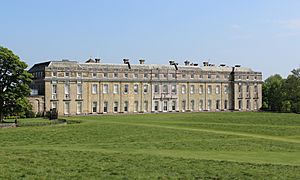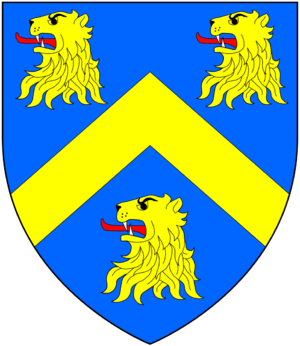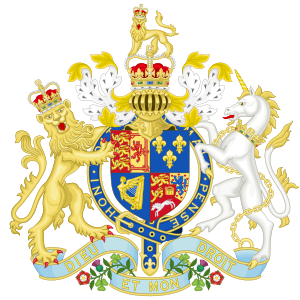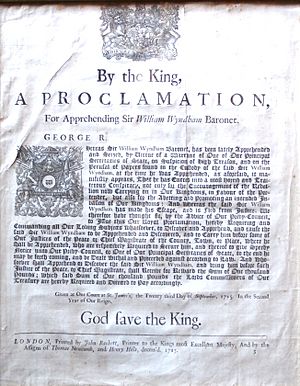Sir William Wyndham, 3rd Baronet facts for kids
Quick facts for kids
Sir William Wyndham
|
|
|---|---|
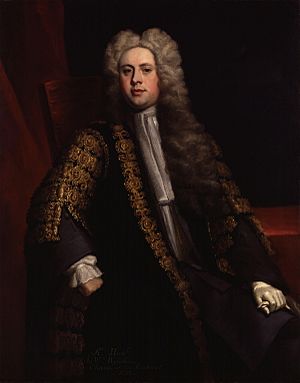
Sir William Wyndham, 1713 portrait by Jonathon Richardson, National Portrait Gallery, London
|
|
| Chancellor of the Exchequer | |
| In office 1713–1714 |
|
| Preceded by | Sir Robert Benson |
| Succeeded by | Sir Richard Onslow |
| Secretary at War | |
| In office 1712–1713 |
|
| Preceded by | George Granville |
| Succeeded by | Francis Gwyn |
| Personal details | |
| Born | 1688 |
| Died | 17 June 1740 (aged 51–52) |
| Spouses | Lady Catherine Seymour Maria Catherina de Jonge |
| Children | 5 |
| Parents | Sir Edward Wyndham, 2nd Baronet Katherine Leveson-Gower |
| Education | Eton College |
| Alma mater | Christ Church, Oxford |
Sir William Wyndham, 3rd Baronet (born around 1688 – died 17 June 1740), was an important English politician from Orchard Wyndham in Somerset. He was a member of the House of Commons from 1710 to 1740.
Sir William was a member of the Tory party. He held important government jobs during the time of Queen Anne (1702–1714). He was the Secretary at War in 1712 and the Chancellor of the Exchequer in 1713.
After Queen Anne, the new King George I came from Hanover, Germany. Sir William was a Jacobite leader. This meant he supported the return of the old Stuart royal family to the throne. He led the Tory opposition in the House of Commons against King George I and King George II.
His first wife, Lady Catherine Seymour, brought a lot of wealth to the family. She inherited half of the huge estates of the Percy family. These included Petworth House in Sussex. Because of this, his oldest son became the 2nd Earl of Egremont. His daughter, Elizabeth Wyndham, married a Prime Minister, George Grenville. She was also the mother of another Prime Minister, William Wyndham Grenville.
Sir William also helped build the pier at Watchet harbour, near his home.
Contents
Family Background and Early Life
Sir William Wyndham was the son of Sir Edward Wyndham, 2nd Baronet. His father was also a Member of Parliament for Ilchester. His mother was Katherine Leveson-Gower.
He went to school at Eton College and then studied at Christ Church, Oxford University.
Political Career and Challenges
Sir William became a Member of Parliament for Somerset in 1710. He quickly rose in the Tory government. He became Secretary at War in 1712. This role involved managing the army. In 1713, he became Chancellor of the Exchequer, which meant he was in charge of the country's money.
He was a close friend of Lord Bolingbroke, another important Tory leader. They both wanted to bring back the Stuart royal family after Queen Anne died. This plan failed. When King George I took the throne, Sir William lost his government jobs. He was even held for a short time in 1714.
Leading the Opposition
When King George I became king, Lord Bolingbroke left England. Sir William Wyndham then became the main leader of the Jacobites in England. The Jacobites wanted to remove King George and put the "Old Pretender" (the Stuart heir) on the throne.
In 1715, there was a plan for a rebellion. Sir William encouraged the Pretender to come to England quickly. However, the government found out about the plan. Sir William's role was discussed by the King's advisors. His father-in-law, the Duke of Somerset, tried to protect him. But the government decided to have Sir William arrested.
The King sent a message to the House of Commons. He asked for permission to arrest six members, including Sir William Wyndham. The House agreed.
Soldiers were sent to arrest Sir William at his home. They found papers that showed his involvement in the plot. Sir William promised to surrender later that morning. But he escaped through a window and rode away on a horse. The King then offered a large reward of £1,000 for his capture.
Realizing he could not hide forever, Sir William disguised himself and visited his father-in-law. Then he went to London and gave himself up. He was taken to the Tower of London. His father-in-law tried to get him released on bail, but this was refused. The Duke of Somerset was later removed from his high position in the King's government.
Sir William Wyndham remained a strong leader of the Tory opposition. He fought against the policies of Sir Robert Walpole, who was a very powerful minister. Sir William stayed in touch with Lord Bolingbroke, who was still in exile. They continued to make plans to challenge Walpole's power.
Parliamentary Reports and Public Life
Sir William Wyndham's speeches in Parliament were sometimes reported in a magazine called the Gentleman's Magazine. To avoid problems, the reports used fake names for the speakers. Sir William was called "Gumdahm." These reports were written to sound like the famous book Gulliver's Travels.
Even with his political struggles, Sir William was a respected public figure. He was one of the first leaders of the Foundling Hospital. This was a very important charity in London. It was the country's first home for abandoned children. Many other important people also supported this charity.
Family Life and Descendants
Sir William Wyndham married twice. His first wife was Lady Catherine Seymour. She was the daughter of Charles Seymour, 6th Duke of Somerset. Through her, the Wyndham family gained control of huge estates. These included Petworth House and Egremont Castle.
Sir William and Lady Catherine had two sons and three daughters:
- Charles Wyndham, 2nd Earl of Egremont (1710–1763): He inherited his father's title. Later, he also became the 2nd Earl of Egremont.
- Percy Wyndham-O'Brien, 1st Earl of Thomond (around 1713/23-1774): He became the Earl of Thomond. He did not have children, so his title ended when he died.
- Elizabeth Wyndham: She married George Grenville, who became a Prime Minister. Her son, William Wyndham Grenville, also became a Prime Minister.
Sir William's second wife was Maria Catherina de Jonge. She was the widow of William Godolphin, Marquess of Blandford.
Death
Sir William Wyndham died on 17 June 1740, in Wells, Somerset. He passed away after falling from his horse while hunting.
Portraits
Paintings of Sir William Wyndham can be seen at Orchard Wyndham, Petworth House, and other family homes.


